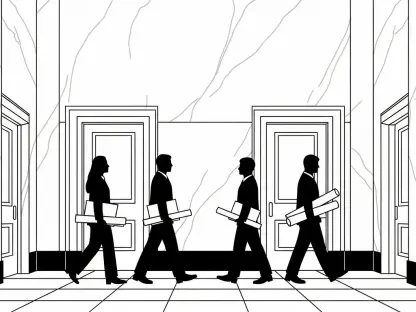Imagine a tire manufacturing facility in North Carolina, once a hub of industrial progress, now at the center of a legal storm involving over 150 former employees claiming health damages from asbestos exposure. This scenario sets the stage for a pivotal court decision involving William Wesley Huffstetler’s workers’ compensation claim against Continental Tires. The North Carolina Court of Appeals’ ruling to revive this case has sparked widespread discussion among legal scholars, insurance professionals, and industry advocates. This roundup gathers diverse perspectives on the implications of this landmark reversal, exploring how it reshapes the landscape of mass tort litigation and procedural fairness in occupational disease claims. The purpose is to distill varied opinions and offer a comprehensive view of what this decision means for claimants, corporations, and insurers alike.
Diverse Perspectives on a Landmark Legal Reversal
Unpacking the Case Background and Broader Impact
The Huffstetler case stems from allegations of asbestos exposure at Continental Tires’ North Carolina plant, where numerous workers have filed claims asserting severe health impacts. Legal analysts highlight that this individual claim, though specific, mirrors a larger wave of litigation affecting a significant group of former employees. Their collective grievances underscore a pressing need to address historical workplace hazards in industrial settings, placing this case under intense scrutiny.
Industry observers note that the decision to revive this claim by the appeals court serves as a critical juncture in occupational disease litigation. Many argue that it reinforces the urgency of revisiting safety protocols and compensation mechanisms for workers exposed to toxic substances. This perspective emphasizes the case’s role as a catalyst for broader policy discussions on workplace protections across similar industries.
A contrasting viewpoint from corporate defense circles suggests that such reversals could burden companies with prolonged legal battles, even when prior rulings seem conclusive. This opinion reflects concern over the potential for increased litigation costs and the challenge of defending against claims spanning decades. The debate around this case thus encapsulates a tension between accountability and operational feasibility for large employers.
Procedural Fairness in Focus: Varied Opinions
Legal experts focusing on procedural law commend the court’s stance on ensuring individual consideration for claimants like Huffstetler, who was not part of the initial bellwether trials used to streamline similar cases. They argue that the rejection of doctrines like collateral estoppel in this context protects fundamental rights to a fair hearing. This view prioritizes justice over expediency in mass litigation frameworks.
On the other hand, some judicial commentators express concern about the strain such rulings place on court systems already grappling with high caseloads. They suggest that while fairness is paramount, the push for individualized reviews could slow down resolutions for other claimants awaiting outcomes. This opinion underscores a practical challenge in balancing equity with efficiency in legal proceedings.
A third perspective from litigation strategists points to the court’s decision as a reminder to avoid over-reliance on representative cases. They note that the unique circumstances of each claimant must guide judicial outcomes, even if it complicates the process. This insight serves as a cautionary note for legal teams aiming to consolidate claims for quicker resolutions.
Bellwether Cases and Mass Tort Challenges: Expert Views
Limitations of Representative Trials
Many legal scholars analyzing the bellwether process argue that while it aims to simplify mass torts by testing representative claims, it often fails to account for non-participating individuals like Huffstetler. They point out that the earlier Hinson ruling, which found insufficient evidence of harmful exposure, was wrongly extended to other cases. This critique highlights a systemic flaw in assuming uniform outcomes across diverse claims.
Insurance industry voices add that such missteps in applying bellwether findings can lead to costly appeals and reversals, as seen in this instance. Their concern centers on the unpredictability introduced into risk assessments when individual cases are reopened. This perspective sheds light on the financial ripple effects for insurers managing large batches of occupational disease claims.
A differing opinion from plaintiff advocacy groups stresses that the court’s ruling corrects an overreach by defendants seeking blanket dismissals. They argue that the inherent diversity in exposure experiences necessitates tailored evaluations, regardless of prior consolidated findings. This stance champions the rights of workers to have their specific grievances addressed in full.
Evolving Trends in Litigation Strategies
Commentators on mass tort trends observe a growing judicial emphasis on safeguarding individual rights within large-scale exposure lawsuits. They suggest that the Huffstetler decision aligns with a broader movement to prioritize claimant-specific evidence over procedural shortcuts. This trend could influence how courts nationwide handle similar industrial health claims.
Defense attorneys, however, caution that this shift might encourage more appeals, complicating litigation timelines for corporations tied to historical hazards like asbestos. Their viewpoint reflects apprehension about adapting strategies to address increasingly detailed judicial expectations. Such concerns point to a potential reshaping of defense approaches in upcoming cases.
Policy analysts offer another angle, proposing that this ruling may prompt legislative bodies to refine guidelines for managing mass claims. They argue that clearer frameworks could help balance efficiency with justice, preventing future procedural disputes. This forward-thinking opinion underscores the case’s potential to drive systemic change beyond the courtroom.
Corporate and Insurance Implications
Insurance professionals express unease over the heightened scrutiny this decision brings to managing occupational disease claims in bulk. They note that the ruling necessitates more detailed claim evaluations, increasing administrative burdens and potential payouts. This perspective highlights a significant operational challenge for insurers in similar litigation.
Corporate risk managers, conversely, see the ruling as a signal to bolster internal documentation and safety records to preempt future claims. Their advice centers on proactive measures to mitigate legal exposure in industries with past ties to hazardous materials. This practical takeaway aims to fortify company defenses against similar lawsuits down the line.
A balanced view from legal consultants suggests that both insurers and corporations must adapt by investing in case-specific analyses rather than relying on precedent alone. They warn that failure to do so risks further appellate setbacks, as demonstrated here. This insight bridges the concerns of both sectors, advocating for a meticulous approach to claim handling.
Key Takeaways from Varied Stakeholders
Legal educators distill the core lesson from this ruling as the paramount importance of individualized evidence in mass tort scenarios. They argue that the court’s insistence on fairness over generalized outcomes serves as a benchmark for future cases. This takeaway reinforces the need for precision in legal proceedings involving multiple claimants.
Insurance advisors offer practical guidance, urging their peers to develop robust systems for tracking and evaluating unique claim details. Their tip focuses on avoiding the pitfalls of overgeneralization that led to this reversal. Such advice aims to equip professionals with tools to navigate the complexities of occupational disease litigation.
Plaintiff representatives, meanwhile, encourage leveraging this precedent to advocate for fair hearings in similar disputes. They emphasize the empowerment this decision offers to workers seeking redress for workplace harms. Their perspective provides a roadmap for claimants to assert their rights within large-scale legal battles.
Reflections on a Pivotal Moment in Asbestos Litigation
Looking back, the North Carolina Court of Appeals’ decision to revive Huffstetler’s claim against Continental Tires marked a defining chapter in the ongoing narrative of asbestos exposure lawsuits. It underscored a critical judicial commitment to procedural fairness, ensuring that individual voices were not drowned out by the efficiencies of mass litigation. For legal practitioners, insurers, and corporate entities, this moment served as a clarion call to refine strategies and prioritize detailed claim assessments. Moving forward, stakeholders should consider investing in comprehensive case reviews and advocating for updated legislative frameworks to support balanced resolutions. Additionally, exploring collaborative approaches between defendants and claimants could pave the way for more equitable outcomes, ensuring that justice remains at the forefront of occupational disease litigation.









